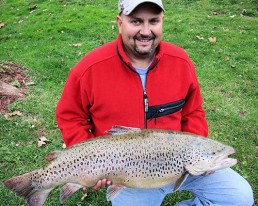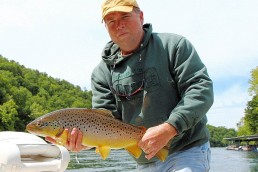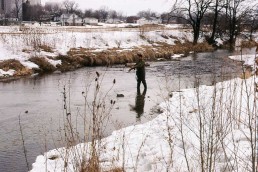Winter a Prime Time to Catch Big Trout in Missouri
SHARE THIS POST
A cool, gray winter mist hangs over the water, creating a surreal scene as an angler wades in the cold shallows. Nearby, a blue heron squawks its displeasure at being disturbed while hunting the shoreline for a minnow.
No bass boat, jon boat or canoe here—this angler chooses to be one with the water, wading slowly one foot at a time, looking for solid footing. An odd-looking figure to some: dull green-colored waders that nearly reach the armpits, a vest loaded with tiny tools such as forceps and scissors and wearing a hat covered with tiny bug imitations.
This angler is after a bragging-size fish from the Trophy Trout release area of Lake Taneycomo’s headwaters near Branson, Mo. The hatch is on, and after a few casts, a 6-pound class rainbow is fooled by a size 18 Midge, fished with a 9-foot, 5-weight fly rod.
Missouri is home to some very large trout. The state records are brook trout from Lake of the Ozarks in 2012 at 1 pound, 14 ounces (an accidental catch), brown trout at 28 pounds, 12 ounces from Lake Taneycomo, and rainbow trout at 18 pounds, 1 ounce from Roaring River State Park.
Trout are not native to Missouri, but the cold water from its many natural springs and water below the Table Rock Dam are excellent habitats for a “put-and-take” fishery. Annual stockings include Bennett Spring (420,000 rainbows), Maramec Spring (140,000 rainbows), Montauk State Park (200,000 rainbows), Roaring River State Park (250,000 rainbows) and Lake Taneycomo at Shepard of the Hills Hatchery (700,000 rainbow and brown trout).
Aside from the state parks, quality trout angling is available in the approximately 120 miles of Ozark streams that are divided into five areas, Blue, Red, and White Ribbon, plus Winter Locations and Lake Taneycomo. The Summary of Missouri Fishing Regulations (mdc.mo.gov) has detailed information about these fishing opportunities.
Trout fishing in Missouri appeals to all categories of angler, from the purist to the novice. Trophy fish in rivers and lakes can be challenging, requiring the best of equipment and presentations while the average fish in Lake Taneycomo might fall for a nightcrawler or a Berkley Gulp Alive Floating Salmon Egg.
Phil Lilley, owner of Lilley’s Landing on Lake Taneycomo, offers suggestions.
“There are four ingredients to successful trout fishing here,” Lilley says. “A 2- to 4-pound line is a must when using almost any kind of trout bait or lure. Exceptions are crankbaits, like Rapalas, Rogues, larger spoons and spinners that require 6- or 8-pound-test.”
He believes the line should be green or clear, not incandescent or blue. Monofilament is good; fluorocarbon is okay, but braid should be avoided. He likes a 5- to 7-foot-long medium to light action ultralight rod and a reel with a good drag that spools plenty of line.
“Small weights, hooks or lures are important because hook size is critical. Numbers 6, 8 and 10 hooks will work for any bait used. Weights should only be heavy enough for successful casting,” Lilley says.
Are you enjoying this post?
You can be among the first to get the latest info on where to go, what to use and how to use it!
He advises patience and a light hand because trout are typically light biters, picking at their food like a little kid eating spinach.
“I’ve witnessed rainbows taking a piece of worm in their mouths only to blow them out,” Lilley added.
Taneycomo is a narrow riverine lake with fish greatly affected by water flow created by generation schedules of electricity at Table Rock Lake.
Lilley believes one of the best ways to catch a number of trout is by using bait. Fish from the bank, a dock, or an anchored boat and cast the bait, allowing it to sink to the bottom. When the trout bites set the hook sharply but reel the fish in gently. Have a landing net handy; remember you are using very light line.
Winter is a prime time for big trout in Missouri, especially at Lake Taneycomo.
“When the water in Table Rock Lake turns over, it provides water with higher oxygen levels which causes our trout to be much more active,” Lilley says.
Some years, winter temperatures reach 70 degrees; other years may dip below freezing with snow and sleet. Anglers overcome inclement weather layering clothes and using hand and feet warmers.
Marabou jigs are a mainstay on the lake because they are inexpensive and can last through catching a dozen or more fish. Lake area tackle shops carry jigs in several different sized weights to cope with Taneycomo’s generation schedule.
“Scuds and midges are also great to try in the upper lake, sometimes with a tandem rig tied with an egg fly or a San Juan worm 18 inches below the scud. We see midge hatches almost every day in the winter here on the lake, and that means our rainbows are ready and waiting to munch on little flies swimming up from the bottom and hatching on the surface.”
It is not too late to plan a winter trout-fishing getaway, especially when it might be 30 to 40 degrees warmer than around the Great Lakes area. Always check winter regulations, because trout streams in some state parks may close during the winter.
MWO
SHARE THIS POST
Did you enjoy this post?
You can be among the first to get the latest info on where to go, what to use and how to use it!
Darrell Taylor
Darrell Taylor has fished for more than 65 years. During the past 25 years, Taylor has generated more than 2,000 published articles, columns and fishing reports. His writings received 14 peer-level awards from outdoor writer organizations, including the Association of Great Lakes Outdoor Writers “Excellence in Craft” Golden Glow Award, their highest recognition.




